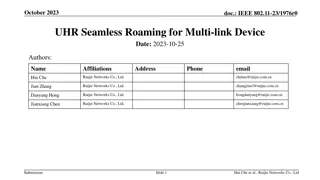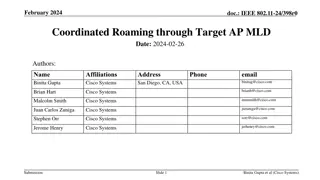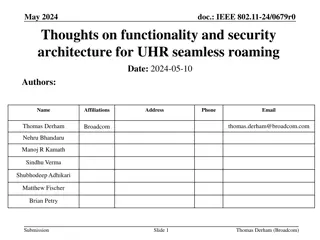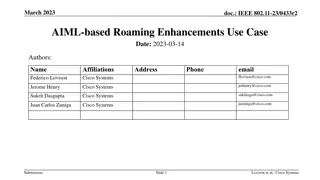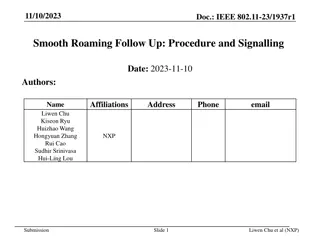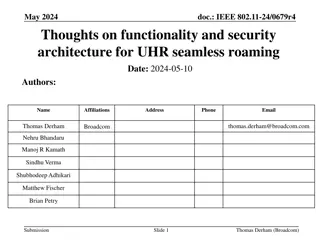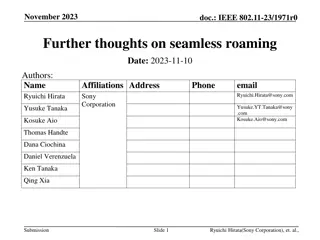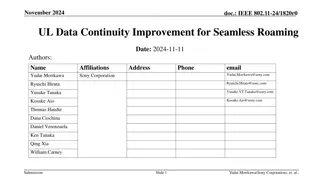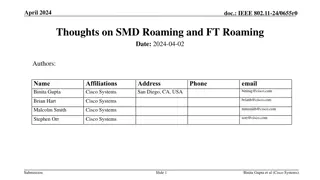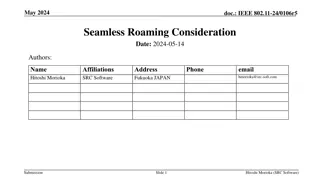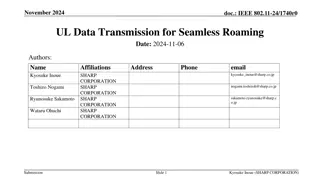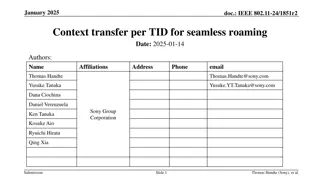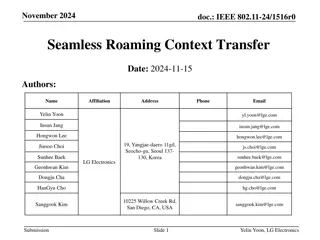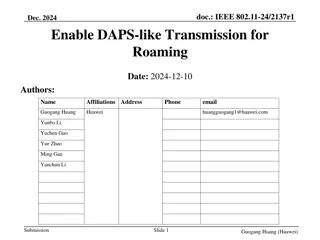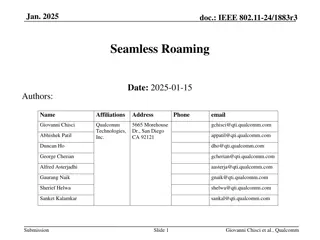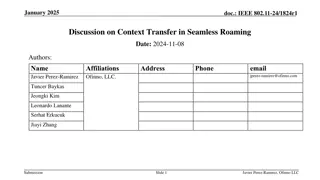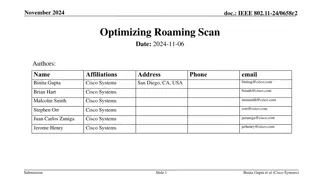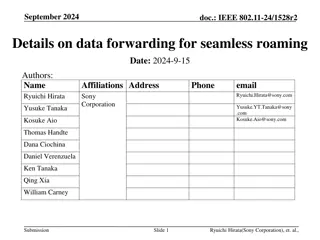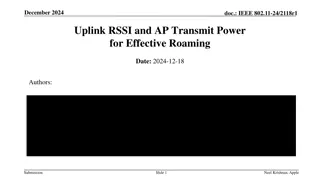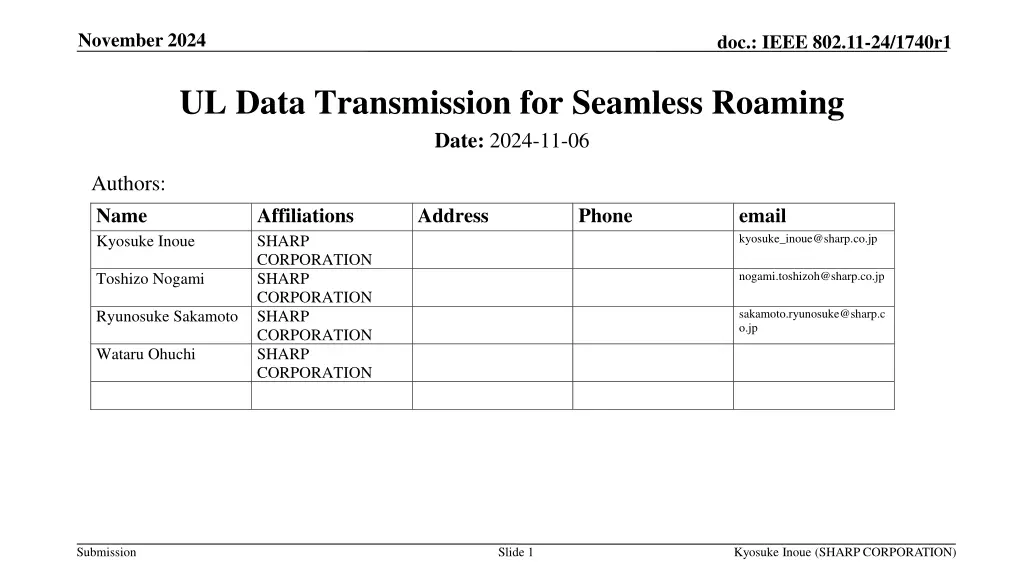
UL Data Transmission for Seamless Roaming in IEEE 802.11-24
Explore UL data transmission strategies for seamless roaming in IEEE 802.11-24 standard, discussing options for non-AP MLD behavior before and after roaming initiation, as presented by Kyosuke Inoue from SHARP CORPORATION.
Download Presentation

Please find below an Image/Link to download the presentation.
The content on the website is provided AS IS for your information and personal use only. It may not be sold, licensed, or shared on other websites without obtaining consent from the author. If you encounter any issues during the download, it is possible that the publisher has removed the file from their server.
You are allowed to download the files provided on this website for personal or commercial use, subject to the condition that they are used lawfully. All files are the property of their respective owners.
The content on the website is provided AS IS for your information and personal use only. It may not be sold, licensed, or shared on other websites without obtaining consent from the author.
E N D
Presentation Transcript
November 2024 doc.: IEEE 802.11-24/1740r1 UL Data Transmission for Seamless Roaming Date: 2024-11-06 Authors: Name Kyosuke Inoue Affiliations SHARP CORPORATION SHARP CORPORATION SHARP CORPORATION SHARP CORPORATION Address Phone email kyosuke_inoue@sharp.co.jp nogami.toshizoh@sharp.co.jp Toshizo Nogami sakamoto.ryunosuke@sharp.c o.jp Ryunosuke Sakamoto Wataru Ohuchi Submission Slide 1 Kyosuke Inoue (SHARP CORPORATION)
November 2024 doc.: IEEE 802.11-24/1740r1 Abstract In this contribution, we discuss UL data transmission during seamless roaming procedure. Submission Slide 2 Kyosuke Inoue (SHARP CORPORATION)
November 2024 doc.: IEEE 802.11-24/1740r1 Background It has been already agreed to define request/response frame for seamless roaming procedure [1]. Motion 44 Define a request frame sent by a non-AP MLD in state 4 to initiate the roaming procedure Define a response frame sent to the non-AP MLD to indicate readiness for the non-AP MLD to send class 3 frames to the target AP MLD Submission Slide 3 Kyosuke Inoue (SHARP CORPORATION)
November 2024 doc.: IEEE 802.11-24/1740r1 UL data transmission after roaming procedure initiation We have the following two options for the non-AP MLD between sending the request frame and receiving the response frame: Option 1: The non-AP MLD stops UL data transmission to the current AP MLD [2-4]. Option 2: The non-AP MLD continues UL data transmission to the current AP MLD. Submission Slide 4 Kyosuke Inoue (SHARP CORPORATION)
November 2024 doc.: IEEE 802.11-24/1740r1 Option 1: The non-AP MLD stops UL data transmission Non-AP MLD Current AP MLD Target AP MLD In Option 1: Before sending the request frame, the non- AP MLD transmits UL data to the current AP MLD. After sending the request frame, the non- AP MLD stops UL data transmission to the current AP MLD and does not transmit UL data until the non-AP MLD receives the response frame from the current AP MLD. After receiving the response frame, the non-AP MLD starts UL data transmission to the target AP MLD. DS UL data transmission via Current AP MLD Request frame DS mapping update Response frame UL data transmission via Target AP MLD Submission Slide 5 Kyosuke Inoue (SHARP CORPORATION)
November 2024 doc.: IEEE 802.11-24/1740r1 Option 2: The non-AP MLD continues UL data transmission In Option 2: Before sending the request frame, the non-AP MLD transmits UL data to the current AP MLD. After sending the request frame, the non-AP MLD continues UL data transmission to the current AP MLD and the current AP MLD delivers the UL data to the DS before DS mapping update. After DS mapping update, the current AP MLD forwards the received UL data to the target AP MLD and the target AP MLD delivers the UL data to the DS. After receiving the response frame, the non-AP MLD starts UL data transmission to the target AP MLD. Non-AP MLD Current AP MLD Target AP MLD DS UL data transmission via Current AP MLD Request frame UL data transmission via Current AP MLD DS mapping update UL Data forwarding Response frame UL data transmission via Target AP MLD Submission Slide 6 Kyosuke Inoue (SHARP CORPORATION)
November 2024 doc.: IEEE 802.11-24/1740r1 Comparison between Option 1 and Option 2 The following table compares between Option 1 and Option 2. Both options have different benefit compared to the other option. UL data can be sent in low latency in Option 2 while Option 1 can make AP MLD to implement easier. Option 1 Large Low Option 2 Small High UL transmission delay Implementation complexity for AP MLD Option 2 will have an essential role for satisfying the demand of industrial use cases (e.g. AGV). Enhanced AGV system requires low latency not only for DL but also for UL. Option 2 should be supported in addition to Option 1. Submission Slide 7 Kyosuke Inoue (SHARP CORPORATION)
November 2024 doc.: IEEE 802.11-24/1740r1 Ref) 3GPP handover According to the 3GPP specs [5][6], two handover modes have been defined. In 3GPP Normal handover, the UE stops UL data transmission to the Source gNB at the handover initiation, which is similar to Option 1. In 3GPP DAPS handover, the UE continues UL data transmission to the Source gNB at the handover initiation, which is similar to Option 2. Submission Slide 8 Kyosuke Inoue (SHARP CORPORATION)
November 2024 doc.: IEEE 802.11-24/1740r1 Ref) 3GPP Normal handover [5] UE Source gNB Target gNB AMF UPF In 3GPP Normal Handover: Before the handover initiation, the UE transmits UL Data to the Source gNB. At the handover initiation, the UE stops UL Data transmission to the Source gNB and does not transmit UL Data until the handover completion. At the handover completion, the UE starts UL Data transmission to the Target gNB. UL data transmission via Source gNB Normal handover initiation Normal handover completion UL data transmission via Target gNB AMF: Access and Mobility Management Function UPF: User Plane Function Submission Slide 9 Kyosuke Inoue (SHARP CORPORATION)
September 2024 doc.: IEEE 802.11-24/1740r1 Ref) 3GPP DAPS handover [6] In 3GPP DAPS handover: Before the handover initiation, the UE transmits UL Data to the Source gNB. At the handover initiation, the UE continues UL data transmission to the Source gNB until the handover completion. At the handover completion, the UE starts UL Data transmission to the Target gNB. UE Source gNB Target gNB AMF UPF UL data transmission via Source gNB DAPS handover initiation UL data transmission via Source gNB DAPS handover completion UL data transmission via Target gNB DAPS: Dual Active Protocol Stack AMF: Access and Mobility Management Function UPF: User Plane Function Submission Slide 10 Kyosuke Inoue (SHARP CORPORATION)
November 2024 doc.: IEEE 802.11-24/1740r1 Conclusion Both the following modes should be supported for Seamless Roaming: Mode 1: The non-AP MLD stops UL data transmission to the current AP MLD between sending the request frame and receiving the response frame. Mode 2: The non-AP MLD continues UL data transmission to the current AP MLD between sending the request frame and receiving the response frame. Submission Slide 11 Kyosuke Inoue (SHARP CORPORATION)
November 2024 doc.: IEEE 802.11-24/1740r1 References [1] 24/0171, TGbn Motions List - Part 1 [2] 24/0052, Seamless Roaming Details, Duncan Ho [3] 24/0396, Seamless Roaming within a Mobility Domain Follow Up, Binita Gupta [4] 24/0412, Seamless Roaming Procedure Follow-Up, Yelin Yoon [5] 3GPP TS 38.300 V15.5.0 (2019-03) [6] 3GPP TS 38.300 V16.5.0 (2021-03) Submission Slide 12 Kyosuke Inoue (SHARP CORPORATION)
September 2024 doc.: IEEE 802.11-24/1740r1 Appendix: Normal handover in 3GPP [5] UE Source gNB Target gNB AMF UPF(s) User Data User Data 0.Mobility control information provided by AMF 1.Measurement Control and Reports 2. Handover Decision 3. HANDOVER REQUEST 4. Admission Control 5. HANDOVER REQUEST ACKNOWLEDGE 6. RAN Handover Initiation 7. SN STATUS TRANSFER Detach from old cell Synchronise to new cell Deliver buffered data and new data from UPF(s) User Data Buffer User Data from Source gNB 8. RAN Handover Completion User Data User Data 9. PATH SWITCH REQUEST 10. Path Switch in UPF(s) End Marker User Data 11. PATH SWITCH REQUEST ACKNOWLEDGE 12. UE CONTEXT RELEASE Figure 9.2.3.2.1-1: Intra-AMF/UPF Handover [5] Submission Slide 13 Kyosuke Inoue (SHARP CORPORATION)
September 2024 Appendix: DAPS (Dual Active Protocol Stack) handover in 3GPP [6] doc.: IEEE 802.11-24/1740r1 DAPS handover in which the UE connects to the Target gNB without releasing the connection of the Source gNB has introduced in 3GPP. DAPS handover: a handover procedure that maintains the source gNB (base station) connection (including downlink user data reception and uplink user data transmission) after reception of handover command and until releasing the source cell after successful connection to the target gNB Source gNB Target gNB UE Submission Slide 14 Kyosuke Inoue (SHARP CORPORATION)
September 2024 doc.: IEEE 802.11-24/1740r1 Appendix: DAPS (Dual Active Protocol Stack) handover in 3GPP [6] Figure 9.2.3.2.1-1: Intra-AMF/UPF Handover [6] Submission Slide 15 Kyosuke Inoue (SHARP CORPORATION)

